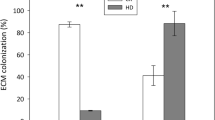Abstract
Considering the ubiquitous heterogeneity in spatial distribution of soil nutrients, we conducted a pot experiment to investigate the foraging traits and growth performance of four important subtropical tree species in a heterogeneous nutrient environment. The tested species exhibited large differences in foraging traits as well as growth benefits obtained from root foraging. Pinus massoniana, Schima superba and Liriodendron chinese all showed a higher degree of root morphological plasticity (expressed as relative fine root mass difference; RFRMD) than Cunninghami lanceolata (P < 0.05). P. massoniana exhibited the largest degree of morphological plasticity, followed by L. chinese and S. superba, whereas there were no significant differences in RFRMD among the three species. S. superba was the only species that exhibiting both morphological plasticity and physiological plasticity. Both P. massoniana and S. superba exhibited greater whole-seedling biomass and high sensitivity in response to nutrient heterogeneity, resulting from both types of plasticity. In contrast, both types of root plasticity were poor for C. lanceolata, resulting in poor growth benefit in heterogeneous environments. As for L. chinese, the root proliferation in nutrient-rich patches occurred at the expense of depressed root growth in other parts of the root system, leading to the lack of increment in total root biomass and nutrient absorption in heterogeneous environments. Our results provide insight and practical advice for silviculture and forest management.



Similar content being viewed by others
References
Blair BC, Perfecto I (2004) Successional status and root foraging for phosphorus in seven tropical tree species. Can J For Res 35:1128–1135
de Kroon H, Visser EJW, Huber H, Mommer L, Hutchings MJ (2009) A modular concept of plant foraging behaviour: the interplay between local responses and systemic control. Plant Cell Environ 32:704–712
Dong M, During HJ, Werger MJA (2002) Root and shoot plasticity of the stoloniferous herb Ajuga reptans L. planted in a heterogeneous environment. Flora 197:37–46
Einsmann JC, Jones RH, Pu M, Mitchell RJ (1999) Nutrient foraging traits in 10 co-occuring plant species of contrasting life forms. J Ecol 87:609–619
Farley RA, Fitter AH (1999) Temporal and spatial variation in soil resources in a deciduous woodland. J Ecol 87:688–696
Forde BG, Walch-Liu P (2009) Nitrate and glutamate as environmental cues for behavioural responses in plant roots. Plant Cell Environ 32:682–693
Fransen B, Blijienberg J, de Kroon H (1999) Root morphological and physiological plasticity of perennial grass species and the exploitation of spatial and temporal heterogeneous nutrient. Plant Soil 211:179–189
George E, Seith B, Schaeffer C, Marschner H (1997) Response of Picea, Pinus and Pseudotsuga roots to heterogeneous nutrient distribution in soil. Tree Physiol 17:39–45
Gloser V, Libera K, Orians CM (2008) Contrasting below- and aboveground responses of two deciduous trees to patchy nitrate availability. Tree Physiol 28:37–44
Hodge A (2004) The plastic plant: root responses to heterogeneous supplies of nutrients. New Phytol 162:9–24
Hodge A, Robinson D, Fitter AH (2000) An arbuscular myorrhizal inoculum enhances root proliferation in, but not nitrogen capture from nutrient-rich patches in soil. New Phytol 145:575–584
Huante P, Rincon E, Chapin FS (1998) Foraging for nutrients, responses to changes in light, and competition in tropical deciduous tree seedlings. Oecologia 117:209–216
Hutchings MJ, Wijesinghe DK (2008) Performance of a clonal species in patchy environments: effects of environmental context on yield at local and whole-plant scales. Evol Ecol 22:313–324
Janecek S, Janeckova P, Leps J (2004) Influence of soil heterogeneity and competition on growth features of three meadow species. Flora 199:3–11
Lechowicz MJ, Bell G (1991) The ecology and genetics of fitness in forest plants. 2. Microspatial heterogeneity of the edaphic envionment. J Ecol 79:687–696
Mari S, Jonsson A, Finlay R, Ericsson T, Kähr M, Eriksson G (2003a) Genetic variation in nitrogen uptake and growth in mycorrhizal and non-mycorrhizal Picea abies (L.) Karst seedlings. For Sci 49:258–267
Mari S, Jansson G, Jonsson A (2003b) Genetic variation in nutrient utilization and growth traits in Picea abies seedlings. Scand J For Res 18:19–28
Mou P, Mitchell RJ, Jones RH (1997) Root distribution of two tree species under a heterogeneous nutrient environment. J Appl Ecol 34:645–656
Pickett STA, Cadenasso ML, Jones CG (2000) Generation of heterogeneity by organisms: creation, maintenance, and transformation. In: Hutchings M (ed) Ecological consequences of habitat heterogeneity. Blackwell, New York, pp 33–52
Robertson GP, Crum JR, Ellis BG (1993) The spatial variability of soil resource following long-term disturbance. Oecologia 96:451–456
Wang L, Mou PP, Jones RH (2006) Nutrient foraging via physiological and morphological plasticity in three plant species. Can J For Res 36:164–173
Wang J, Zhou ZC, Jin GQ (2007) Differences of foraging behavior between provenances of Pinus massoniana in heterogeneous nutrient environment. Acta Ecol Sin 27:1350–1358 (in Chinese)
Zhou ZC, Xie YR, Jin G.Q, Chen Y, Song ZY (2005) Study on phosphorus efficiency of different provenances of Pinus massoniana. Sci Silvae Sin 41:25–30
Zhou ZC, Wang J, Rao LB (2006) Characteristics of phosphorus efficiency of different provenances in Liriodendron Chinese. Sci Silvae Sin 19:211–215
Acknowledgments
I thank the editor and two anonymous reviewers for helpful comments on the earlier version of this manuscript. I thank the experts, i.e. Professor Laurence Roy, Professor Hans de Kroon and Dr. Limin Wu, for their kindly advice and great help in the improvement of the English style in this paper. I also thank members of the Forest Breeding Group of the Research Institute of Subtropical Forestry for discussion, encouragement, and assistance in the pot measurements. This research was supported by a research project from the national natural science foundation of China (30571482).
Author information
Authors and Affiliations
Corresponding author
About this article
Cite this article
Zhang, Y., Zhou, Z., Ma, X. et al. Foraging ability and growth performance of four subtropical tree species in response to heterogeneous nutrient environments. J For Res 15, 91–98 (2010). https://doi.org/10.1007/s10310-009-0153-5
Received:
Accepted:
Published:
Issue Date:
DOI: https://doi.org/10.1007/s10310-009-0153-5




